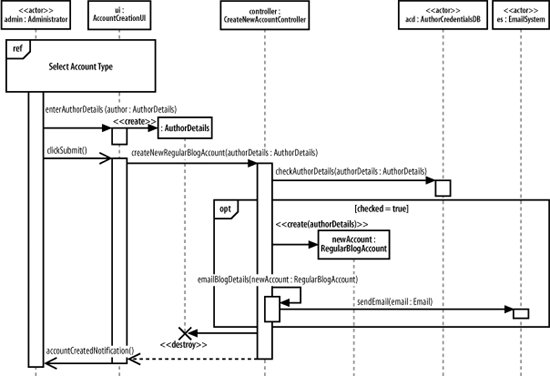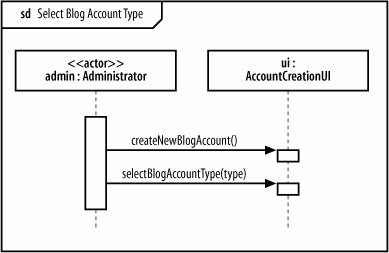Section 7.8. Managing Complex Interactions with Sequence Fragments
7.8. Managing Complex Interactions with Sequence FragmentsMost of what you've seen in this chapter will have been pretty familiar to anyone who has used sequence diagrams in UML 1.x. But now it's time for something completely different. In the bad old days of pre-UML 2.0, sequence diagrams quickly became huge and messy, and contained far too much detail to be easily understood or maintained. There were no built-in, standard ways to show loops and alternative flows, so you had to "grow your own" solutions. This tended to contribute to the size and complexity of the sequence diagrams rather than helping to manage it. Something new was needed to help the modeler work with the detail that a sequence diagram needed to capture, allowing her to create organized and structured sequence diagrams that showed complex interactions such as loops and alternate flows. The answer from the UML 2.0 designers was the sequence fragment. A sequence fragment is represented as a box that encloses a portion of the interactions within a sequence diagram, as shown in Figure 7-19. A sequence fragment's box overlaps the region of the sequence diagram where the fragment's interactions take place. A fragment box can contain any number of interactions and, for large complex interactions, further nested fragments as well. The top left corner of the fragment box contains an operator. The fragment operator indicates which type of fragment this is. Figure 7-19. A sequence fragment located as part of a larger sequence diagram, with notes to indicate the fragment box, any parameters, and its operator In Figure 7-19, the operator is opt, which means that this is an optional fragment. All the interactions contained within the fragment box will be executed according to the result of the fragments guard condition parameter. Some fragment types do not need additional parameters as part of their specification, such as the ref fragment type discussed in the next section, but the guard condition parameter is needed by the opt fragment type to make a decision as to whether it should execute its interactions or not. In the case of the opt fragment type, the interactions that the fragment contains will be executed only if the associated guard condition logic evaluates to true. 7.8.1. Using a Sequence Fragment: The ref FragmentThe ref type of sequence fragment finally alleviates some of the maintenance nightmare presented by the huge sequence diagrams that are often created for complex systems. In Figure 7-20, the ref fragment represents a piece of a larger sequence diagram. The interactions by which the Administrator actor selects a blog account type for creation are now contained within the referenced sequence fragment. Figure 7-21 shows how the referenced fragment can be expressed on a separate sequence diagram. Figure 7-20. Capturing the interactions used to select an account type within a ref sequence fragment Figure 7-21. A referenced sequence diagram that contains the new account selection interactions Along with managing the sheer size of large sequence diagrams, the ref fragment also presents an opportunity to reuse a set of common interactions. Several ref fragment boxes can reference the same set of interactions, thereby reusing the interactions in multiple places.
7.8.2. A Brief Overview of UML 2.0's Fragment TypesUML 2.0 contains a broad set of different fragment types that you can apply to your sequence diagrams to make them more expressive, as shown in Table 7-4.
Sequence fragments make it easier to create and maintain accurate sequence diagrams. However, it's worth remembering that no fragment is an island; you can mix and match any number of fragments to accurately model the interactions on a sequence diagram. Be wary if your diagrams become huge and unwieldy even when you are using fragments, since you might simply be trying to model too much in one sequence. We've given you a brief overview of sequence diagram fragments here. All the different sequence diagram fragment types are a big subject in their own right and are a little beyond the scope of this book. For a more in-depth look at the different types of sequence diagram fragments, see UML 2.0 in a Nutshell (O'Reilly). |
EAN: 2147483647
Pages: 175
